We may be compensated if you purchase through links on our website. Our team is committed to delivering honest, objective, and independent reviews on home products and services.
Preparing the surface properly before starting your paint project is incredibly important. Removing old paint and stains helps your new finish will adhere correctly and last longer. While stripping furniture might seem intimidating, it’s a manageable process with the right approach.
Strip First, Paint Later
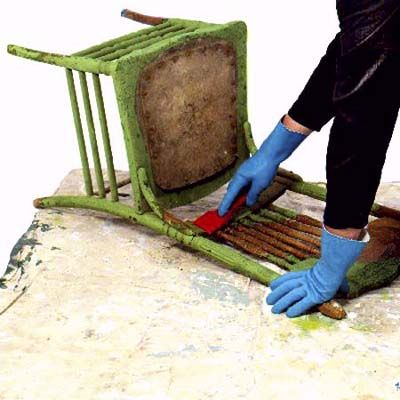
To strip furniture safely:
- Choose a well-ventilated area, preferably outdoors.
- Wear protective gear, including gloves and safety glasses.
- Apply a chemical stripper according to the manufacturer’s instructions.
- Use a putty knife or scraper to gently remove the loosened paint.
- Clean the surface thoroughly with mineral spirits or water, depending on the stripper.
Consider using a heat gun for stubborn areas, but exercise caution to avoid damaging the wood. Once stripped, sand the surface smooth for an ideal painting surface. The effort put into stripping will guarantee your project’s flawless and durable finish.
Check out the This Old House editors’ favorite strippers and more in Secret Potions for Tackling Tricky Cleaning Jobs.
Painting a Set of Dining Chairs
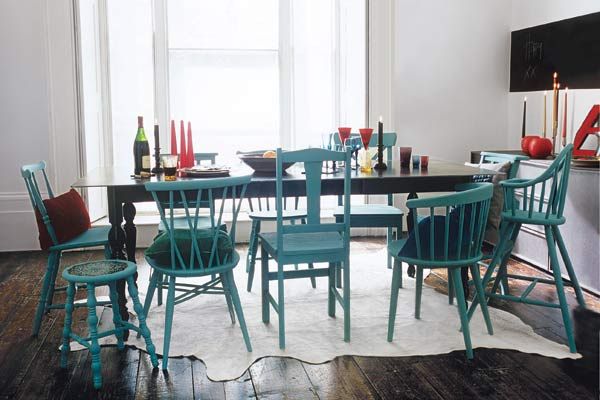
Transforming a mismatched set of dining chairs into a cohesive ensemble is an excellent way to refresh your dining area. This project allows you to express your creativity while unifying your space.
To paint dining chairs effectively:
- Remove any cushions or upholstery.
- Sand the chairs lightly to create a surface that paint can adhere to.
- Apply a primer suitable for the chair material.
- Choose a paint color that complements your dining room decor.
- Apply thin, even coats of paint, allowing each to dry completely.
- Seal the paint with a clear topcoat for durability.
Consider painting each chair a different shade within the same color family for added interest. Additionally, using stencils to add intricate patterns can elevate the appearance of your dining chairs even further.
Upgrade your walls with a cue from Best Colors for Dining Room Drama.
Fake Chalk Paint
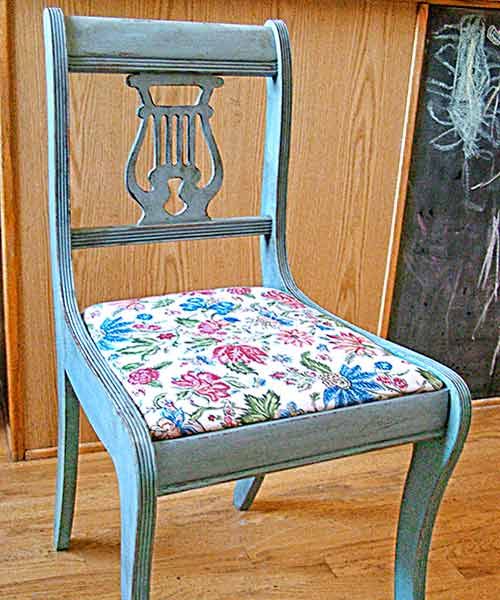
Chalk paint has become increasingly popular for its matte finish and ease of use. However, it can be expensive. Fortunately, you can create a do-it-yourself version that mimics the look of chalk paint at a fraction of the cost. This economical approach allows for frequent updates, keeping your decor fresh.
Kim Hanou of too-much-time.com decided to try a do-it-yourself formula on a secondhand find. See how she did it in Home Bloggers’ Crafty Ways to Save.
To make your own chalk paint:
- Mix 1 cup of latex paint with 1/4 cup of plaster of Paris and 1/4 cup of warm water.
- Stir the mixture thoroughly until smooth.
- Apply to your furniture piece with a brush or roller.
- Allow to dry completely between coats.
This homemade chalk paint provides a finish similar to store-bought versions, and it’s perfect for creating a vintage or shabby chic look on your furniture pieces. You can also enhance the finish by lightly sanding edges for a distressed appearance.
Get an Aged Look With Milk Paint
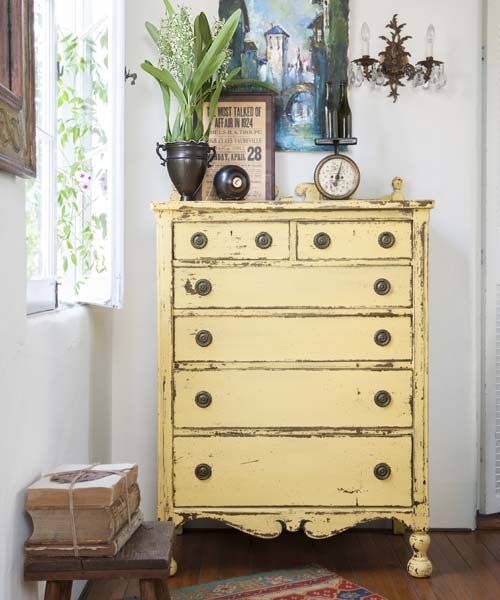
Milk paint is an excellent choice for achieving an authentic aged look on furniture. This natural paint has been used for centuries and is known for its durability and unique finish. Its natural formulation is ideal for eco-conscious decorators.
With our step-by-step project, How To Create an Aged Milk Paint Patina on Furniture, you can give it the correct number of dings and scrapes.
To create an aged milk paint finish:
- Mix milk paint powder with water according to package instructions.
- Apply the paint in thin layers, allowing each to dry completely.
- Sand lightly between coats for a smooth finish.
- Once the final coat is dry, distress edges and high-wear areas with sandpaper.
- Apply a dark wax or glaze to enhance the aged appearance.
Milk paint naturally chips and flakes over time, adding to the authenticity of the aged look. You can apply a resist medium before painting for a more controlled distressed effect.
Find accessories to match your newly aged piece with Period-Style Products to Suit Any Budget.
Overlays for Added Dimension

Adding overlays to plain furniture pieces is an excellent way to create visual interest and dimension. This technique can transform a simple side table or mirror into a statement piece, making ordinary furniture extraordinary.
To add overlays to furniture:
- Choose overlays that complement the style of your piece.
- Measure and mark placement carefully before attaching.
- Use wood glue or construction adhesive to secure overlays.
- Allow the adhesive to dry completely.
- Prime and paint the entire piece, including the overlays.
Paint the overlays the same color as the furniture for a cohesive look. Alternatively, use a contrasting color to make the overlays stand out as a decorative element. Creating custom shapes and patterns with overlays adds an artistic touch to your furniture pieces.
Make a color choice you won’t regret with our advice on How To Pick a Paint Color.
Legs of a Different Color
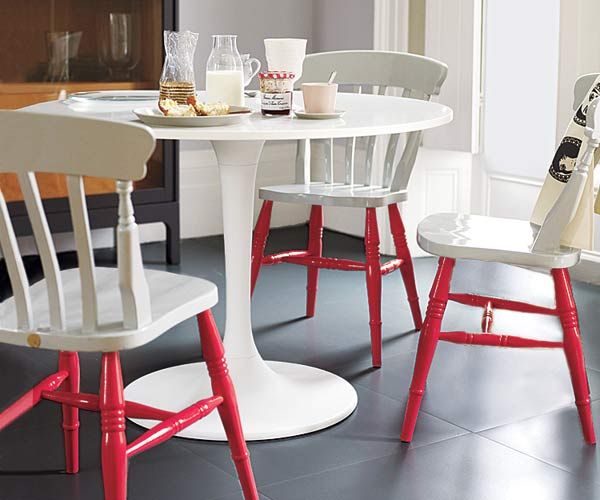
Painting furniture legs a different color is a simple yet effective way to add visual interest to your pieces. This technique works well on dining chairs, side tables, and dressers. Updating the legs can reinvigorate the entire piece, lending a contemporary flair.
To paint furniture legs:
- Remove any hardware and tape off where the legs meet the furniture body.
- Sand the legs lightly to create a surface for paint adhesion.
- Apply a primer suitable for the leg material.
- Paint the legs in your chosen color, applying thin, even coats.
- Seal with a clear topcoat for durability.
Consider using metallic paint for a touch of glamour or a bold, contrasting color for a modern look. You might also opt for patterns like stripes or dipped effects for added pizzazz.
In 88 Quick and Easy Decorative Upgrades, you can learn how to properly coat the legs of your dining chairs.
Glazed Herringbone Tabletop
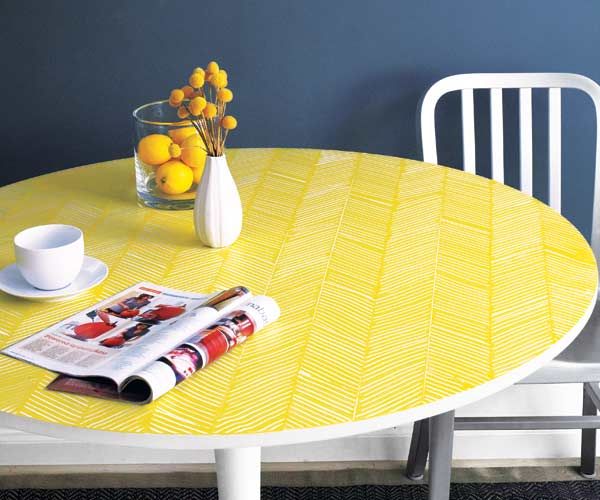
Creating a herringbone pattern on a tabletop adds sophistication and visual interest to an otherwise plain surface. This technique requires patience but yields stunning results. The intricate design makes any tabletop a center of attention in your room.
To create a glazed herringbone tabletop:
- Paint the tabletop a base color and allow it to dry completely.
- Use painter’s tape to create a herringbone pattern.
- Apply a contrasting color over the tape.
- Remove the tape carefully while the paint is still wet.
- Once dry, apply a glaze over the entire surface for depth and sheen.
The glaze adds a beautiful finish and helps protect the painted surface from wear and tear. Using varying shades within the same color family can create a more textured appearance, adding to the tabletop’s elegance.
Witness the magic a paint comb can bring by following our project, How To Create a Herringbone-Pattern Tabletop.
Become a pro when cleaning paint lines by consulting our guide on Using Masking Tape.
Fresh Stripe Approach
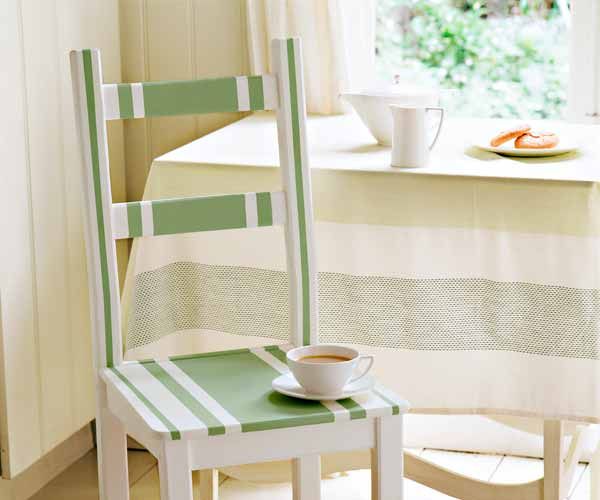
Painting stripes on furniture is a versatile technique that can create various looks, from bold and modern to subtle and sophisticated. This approach works well on chairs, dressers, and even bookcases. The flexibility of stripe placement opens endless design possibilities.
To paint stripes on furniture:
- Paint the entire piece in your base color.
- Use painter’s tape to mark off your stripe pattern.
- Paint between the tape lines with your accent color.
- Remove the tape while the paint is still slightly wet for crisp lines.
- Seal the piece with a clear topcoat for protection.
Experiment with different stripe widths and orientations to create unique designs. Vertical stripes can make a piece appear taller, while horizontal stripes can give the illusion of width. Diagonal stripes offer an unconventional and dynamic look, perfect for eye-catching decor.
Take a deeper dive with our simple tutorial in How To Makeover a Chair With Stripes.
Colorful Painted Bookcases
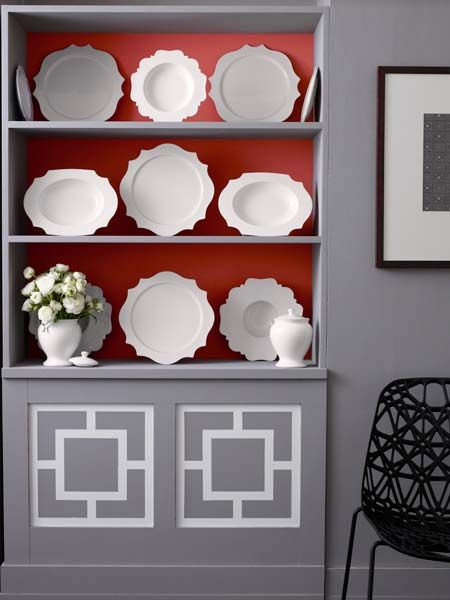
Painting the back of a bookcase is an easy way to add color and depth to your shelving unit. This technique can make your displayed items pop and add visual interest to the room. Colorful back panels can turn an ordinary bookcase into a lively focal point.
To paint bookcase backs:
- Remove all shelves if possible.
- Clean the back panel thoroughly.
- Apply painter’s tape around the edges of the back panel.
- Paint the back panel in your chosen color.
- Allow the paint to dry completely before replacing the shelves.
Consider using a bold, contrasting color for maximum impact or a subtle hue for a more understated look. This technique works well for both built-in and freestanding bookcases.
Colorful Bookcases Beyond the Back Panel
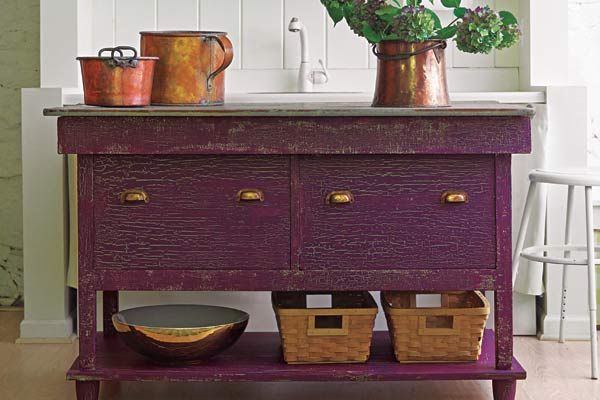
There are many ways to add color to bookcases beyond painting the back panel. Consider painting the shelves themselves or the outer frame for a different effect. Creative shelf painting can transform the entire look of the bookcase.
To add color to bookcase shelves:
- Remove the shelves and sand them lightly.
- Apply a primer suitable for the shelf material.
- Paint the shelves in your chosen color.
- Allow the paint to dry completely before reinstalling.
Alternating shelf colors or creating an ombre effect can add a playful touch to your bookcase design. Incorporating geometric or organic patterns on the shelves can provide an artistic flair, making your bookcase an interactive part of your decor.
Cracks and crevices are attractive on few things besides pieces of furniture—but we love them there. Speed up the aging process with How To Paint a Crackle Finish on Furniture.
Our Conclusion
Paint upgrades offer a cost-effective and creative way to breathe new life into old furniture. Whether you’re looking to unify mismatched pieces, add visual interest to plain surfaces, or create a vintage look, these techniques provide endless possibilities.
